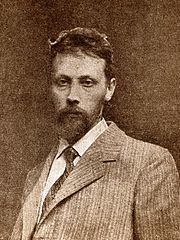Name Antoni Wiwulski | Role Architect | |
 | ||
Structures Vilniaus Svc. Jezaus Sirdies parapija | ||
Antoni Wiwulski or Antanas Vivulskis (1877–1919) was a Polish-Lithuanian architect and sculptor.
Biography
He was born February 20, 1877 in Totma in Vologda Governorate in the Russian Empire, where his father, of Lithuanian (Samogitian) origin, served as a forest superintendent. He graduated from the reputable Jesuit boarding school Zaklad Naukowo-Wychowawczy Ojcow Jezuitow w Chyrowie and then two of the most prestigious art and architecture universities of the epoch: the Ecole Superieure des Beaux-Arts in Paris and the Higher Technical School in Vienna.
Among the most notable of his works are:
The latter building was started in 1913 and was the first example of usage of reinforced concrete in former Polish-Lithuanian Commonwealth. Wiwulski, astonished by the possibility to build gigantic buildings of the newly rediscovered material prepared a project of a giant church with a stylised gigantic sculpture of the Creator sitting on the dome. However, the project was discontinued after Wiwulski's death on January 10, 1919.
In 1919, despite suffering from tuberculosis, he volunteered for the Polish militia (Lithuanian and Belarusian Self-Defence) and took part in the defence of Vilnius against the Bolshevik assault in the early stages of atrocities during the Lithuanian–Soviet War and Polish-Bolshevik War compains. He contracted pneumonia while on guard in the Vilnius' suburb of Uzupis. After his death he was buried in the cellars beneath the church he had designed. When it was converted by the Soviets into a Palace of the Construction Workers in 1964 his ashes were moved to Rasos Cemetery.
A monograph on Wiwulski was published by Nijole Tolvaisiene in 2002
